mobile View, to the German Version tap the flag


- State of Israel
- parliamentary republic within borders,
which contradict the UNO-decision from 1947 and the UNO-resolutions Nr. 181 and Nr. 242
- own name: Medinat Jisrael
• Flags
• Historical Flags
• Meaning/Origin of the Flag
• Coat of Arms
• Meaning/Origin of the Coat of Arms
• Aircraft Roundel
• Map
• Numbers and Facts
• History
• Origin of the Country's Name
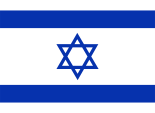
National flag,
ratio = 8:11,
Source, by: Flaggen und Wappen, Corel Draw 4





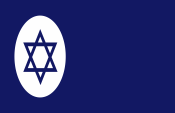
Merchant flag,
ratio = 29:45,
Source, by: Flaggen und Wappen, Corel Draw 4




Naval flag,
ratio = 29:45,
Source, by: Flaggen und Wappen, Corel Draw 4



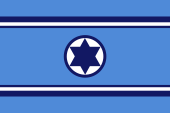
Flag of the Air Force,
ratio = 2:3,
Source, by: Flags of the World, Wikipedia (EN)




Standard of the President on land,
ratio – ratio = 1:1,
Source, by:
Flaggen und Wappen



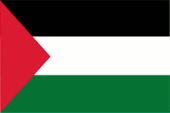
Flag of the autonomous Palestinian territories,
ratio – ratio = 2:3,
Info? click here: Palestina






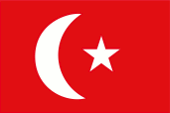
to 1916,
Flag of the Ottoman Empire,
Source, by:
Wikipedia (EN)




1916–1927,
Flag of United Kingdom,
ratio = 1:2,
Source, by:
Flags of the World





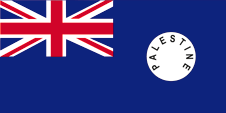
1927–1948
Flag of the government (state flag),
ratio = 1:2,
Source, by:
Flags of the World



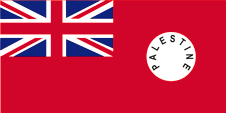
1927–1948
Merchant flag,
ratio = 1:2,
Source, by:
Flags of the World




The flag of Israel is white with a blue David's star in the middle and shows above and below per one blue stripe. The ratio of the breadth of the thereby arising white and blue stripes is like 14:30:85:30:14. It was designed by the zionist leader David Wolfsohn and was showed for the first time in the public on the 21th of July in 1891 at the official opening of the Zion hall in Boston (USA). On the 14th of May in 1948 it was hoisted up for the first time in Palestina and on the 12th of September in 1948 it was officially confirmed as the flag of the jewish state. The David's star is a jewish symbol. It is formed by the combination of two isosceles triangles. Blue and white are colours of jewish ritual clothing and the flag has, ccording to David Wolfsohn, it's roots in the jewish prayer scarf (Talit). Often, however, the following is said: Seeing that the flag was created by a Zionist is it likelyer that there is not reproduced an outward sign of jewish religion, but it is pictured an about the country Israel itself refered declaration. In this way the flag should be to see as an interpretation of the chapter 15 verse 18 of the 1st book of Moses (Genesis 15:18) in which is symbolized the position of the by Abraham to the jews promised land between Nile and Euphrat: On that day the Lord made a covenant with Abram, saying, "To your descentants I give this land, from the river of Egypt to the great river, the river Euphrates." There is no information or source that precisely defines the shade of blue. This applies to all three shades, the medium blue of the national flag, the navy blue of the sea flags and the light blue of the air force flag. For the national flag, Pantone 300 can be found, Pantone 281 and Pantone 286. The blue in the sea flags is called navy blue, according to the colour chart of the British Armed Forces flag catalogue "Flags of all Nations", navy blue would be defined as Pantone 282, the light blue of the air force as azure Pantone 549.
Source:
Die Welt der Flaggen,
Flaggen Wappen Hymnen,
Flaggen und Coat of arms of the Welt,
Wikipedia (DE),
Wikipedia (EN),
Flags of the World,
Flags of all Nations


Coat of arms of Israel,
Source, by:
Flaggen und Wappen

The coat of arms of the state was officially introduced on the 11th of February in 1949. It shows the Menorah, the seven-armed candelabra of the ancient Jerusalem temple and is bordered to the left and to the right by two olive twigs. Underneath in Hebrew fonts the name of the country.
Source:
Flaggen Wappen Hymnen


Aircraft Roundel,
Source, by: Wikipedia (EN)

Location:
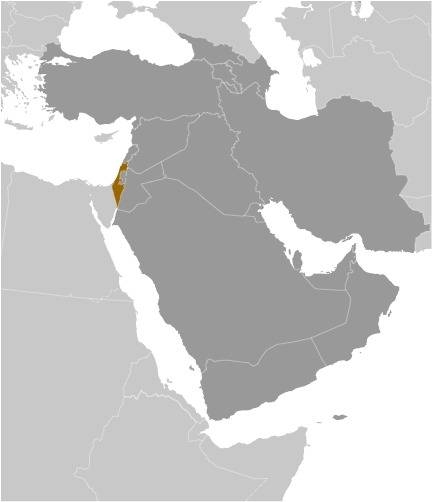
Source: CIA World Factbook
Map of the country:
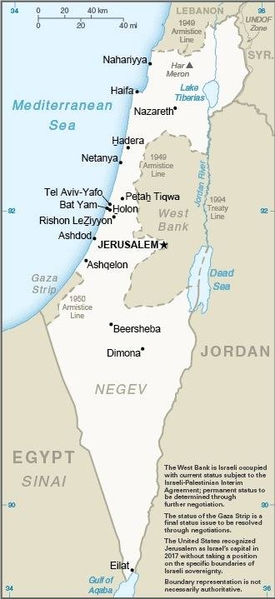
Source: CIA World Factbook

Area according to UN decision 1947: 5.405 square miles
Area, without occupied territories:: 8.644 square miles
Area, with occupied territories: 11.278 square miles
Inhabitants: 9.136.000 (2019), thereof 74% Jews, 21% Arabs
Religions (2009): 35% Non-Religious, 24% traditional Jews, 17% Muslim, 11% orthodox Jews, 5% ultra-orthodox Jews, 2% Christians, 2% Druze
Density of Population: 810 inh./sq.mi.
Capital: Jerusalem (Al Kuds), –internationally barely recognized– 919.438 inh. (2018)
official Languages: Iwrith (New Hebrew), Arabian
other Languages: Russian, German, Jiddic, English
Currency: 1 New Israel Shekel (ILS, NIS) = 100 Agorot
Time Zone: GMT + 2 h
Source:
Wikipedia (DE)

History to 1862, look → Palestina
1862 · development of the Zionism as jewish national movement
1917 · Balfour-Declaration – United Kingdom demands large parts of the Ottoman Empire after the forthcoming end of the war and is in agreement with the idea of the creation of a „national homestead“ for the jews in this area
1920 · the treaty of San Remo assignes United Kingdom as a mandate of the League of Nations the countries Palestina, Transjordan and Iraq
1922 · Palestina (including Jordan) becomes a British mandate of the League of Nations
1923 · Jordan becomes separated es Emirate of Transjordan
1929 · bloody quarrels between Arabs and Jews
1936 · after a many years lasting strong jewish immigration and none reaction of the British mandate force and none guaranties for the independence of an Arabian Palestina arises an Arabian national rebellion
1939 · annihilation of the last Arabian resistance, British promise for a common jewish-arabian state within 10 years
1942 · Zionists claim in New York the formation of a jewish state within Palestina
29th of November in 1947 · UN-Resulution about the formation of a jewish state (Israel) and an arabian state (Palestina) on the area of the mandate territory of Palestina → dismissed by the Arabs → civil war
14th of May in 1948 · the British mandate for Palestina ends, proclamation of the State of Israel
1948–1949 · Israeli-Arabian war, annexation of 2.587 square miles of Arabian territory by Israel, expulsion of the here resident Arabian population, the Palestinians disclaim the proclamation of an Arabian state because this will imply the recognition of the partition of the country and the Israeli annexations
11th of May in 1949 · Israel becomes a member of the UN
1950 · "return law", all jews which settle in Israel get immediately the citizenship, 1,7 millions of jews come into the country
24th of April in 1950 · Transjordan assumes the administration of the Western Jordan Land and nominates itself now Jordan, Egypt assumes the administration of the Ghaza Stripe
29th of October in 1956 · Israeli aggression against Egypt, occupation of the Sinai Peninsula and the Ghaza Stripe → intervention of the USA, the Soviet Union and the UN
25th of December in 1956 · the Israeli troops have to leave the Sinai, stationing of UN-troops
8th of March in 1957 · the Israeli troops have to leave the den Ghaza Stripe, stationing of UN-troops
1967 · withdrawal of the UN-troops
5th of June in 1967 · Israel attacks Egypt, Syria and Jordan and occupies within six days ("Six Days War") the whole Sinai Peninsula, the Ghaza Stripe, the Western Jordan Land, East Jerusalem and the Syrian Golan Heights
1969–1970 · battles with Egypt near the Suez channel
6th of October in 1973 · Egypt and Syria attack Israel unsuccessfully to win back the occupied territories (Jom Kippur War)
1974 · Israeli-Egyptian peace agreement
1974 · Israeli-Syrian agreement, partial withdrawal of the Israeli troops from the Golan Heights
1975 · Israeli-Egyptian peace agreement, partial withdrawal of the Israeli troops from the Sinai Peninsula
1978 · Israeli-Egyptian peace agreement of Camp David
26th of March in 1979 · Israeli-Egyptian peace treaty
1982 · withdrawal of the last Israeli troops from the Sinai Peninsula
6th of June in 1982 · against Palestinian troops (PLO) addressed Israeli attack against Lebanon, the PLO has to leave Lebanon
1985 · partial withdrawal of the Israeli troops from Lebanon, a broad frontier stripe stays occupied
1988 · Jordan disconnects itself from the Western Jordan Land
13th of September in 1993 · arrangement between Israel and the PLO, withdrawal of the Israeli troops from the Ghaza Stripe and Jericho, establishing of a limited local Palestinian self administration
1994 · Israeli-Jordanian peace treaty, establishment of first Palestinian Autonomy Administrations in Jericho and in the Ghaza Stripe
1995 · partial withdrawal of the Israeli troops from the Western Jordan Land, Palestinian Autonomy Administrations in further towns
1996 · election of the Palestinian Autonomy Counsel with a President on the top
2001 · withdrawal of the Israeli troops from the south Lebanese frontier stripe
August 2006 · Israeli troops invade in Lebanon, in 34 days of war there was no success to weaken the Hisbolla Militia, the south of Lebanon becomes appreciably destroyed by the campaigns of the Israeli
2007 · struggles between the Palestinian factions of Hamas and Fatah, Hamas conquers the whole Ghaza Stripe and claims the leadership in Palestine
2008–2009 · Israeli military operation in the Gaza Strip
2014 · Israeli military operation in the Gaza Strip
7th of October in 2023 · Hamas invades the surrounding Israeli territory from the Ghaza Strip and covers the region with religiously charged terror; within two days, Israel regains control over its territories and fights Hamas structures in the Ghaza Strip in the weeks that follow
Source:
Atlas zur Geschichte,
Wikipedia (D),
Weltgeschichte,
Discovery '97

The name "Israel" is mentioned for the first time around 1210 B.C. on the Israel-Pillar of Pharaoh Merneptah. This then referred to the tribes of the Hebrews who lived in Canaan. The name Israel was chosen in 1948 on the occasion of the establishing of the state. Other proposals were: Zion, Judea, New Judea.
Source:
Wikipedia (D)


![]()
































